The Cold War Track Series 1958-1965
At the height of the cold war, the USA and USSR engaged in a series of dual track meets that saw some of the most intense competition in the whole history of the sport. Sports Illustrated came to regard this almost annual meet as “The most important track meet the US takes part in except for the Olympic Games.” (July 27, 1964) Kenny Moore, the great American track writer, called it “One of the Cold War’s great events.” (p. 109)
By 1958, when the series began, the cold war was reaching fever pitch. The threat of a nuclear holocaust was on everyone’s mind. And the two great nations were learning how to deal with each other’s nuclear ability. In some ways, the athletic competition became a non-military battle with propaganda well to the fore. Thus the competition was intense. Before the first encounter in 1958, American coach George Eastment told the US team, “There are international tensions in the world and today is very important.” (Sports Illustrated, Aug 4, 1958)
There were seven dual meets in the series. They were held annually from 1958, with a gap in the Olympic year of 1960. The eighth match of the series was scheduled for Berkeley, California, on July 17-18, 1966. But six days before, at a time when the US was stepping up bombing attacks in Vietnam, the Soviet government announced that the USSR team had voted not to come to the US: “Our hatred for the American military, who are perpetrating atrocities in Vietnam, and our solidarity with the people of Vietnam, who are fighting for their freedom and independence, does not permit us to take part in a match with sportsmen of a country from where this aggression comes.” The Cold War had finally brought the series to an end.
Following World War 2, the US had not participated in dual meets (two countries competing with two athletes per event). Such meets were common in Europe, where rivalries between countries (Sweden v. Finland, for example) produced some great competition. The superpower rivalry between the US and USSR certainly took dual meets to an even higher level. This article focuses just on the men’s running events from 800 to 10,000. The Russian names are italicized in the result lists.
ROUND 1
Moscow, July 27-8, 1958.
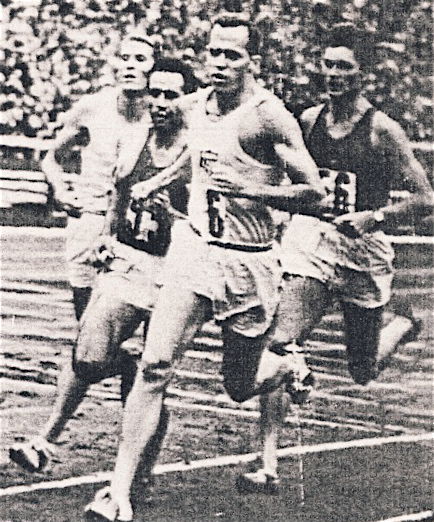 |
| Tom Courtney on his way to an800 victory in the 1958 meet. |
Contrary to expectations, the American team was welcomed with flowers and a 200-person delegation in the early hours. The Russians pulled out all stops to make their guests comfortable, even providing jazz on loudspeakers during their practice sessions.
The Soviet authorities clearly hoped this inaugural meet would be an opportunity for some patriotic propaganda. But they soon changed their minds. When the Americans won the first three events, Radio Moscow terminated its coverage. Moscow TV did the same a little later.
American runners almost held their own, thanks to their superiority at the two shorter distances.
800 Olympic champ Tom Courtenay lead all the way, despite suffering from a fever. He passed 400 in 54.6 and proved far too strong for his opponents. Both Russians outsprinted the other American, Mike Peake.
1. Courtenay 1:48.8; 2. Govorov 1:50.4; 3. Varrak 1:50.4; 4. Peake 1:51.4.
1,500 The two Russians originally slated for this event both had faster times than the Americans, but neither showed up. Instead, two lesser runners were representing the Soviets, although Pipyne had clocked 3:41.1 the previous year (sixth fastest in the world). Jim Grelle, the American number one, was at 21 still developing. He had been runner up in the NCAA Mile for two years. Grelle let the Russians dictate the pace, waiting till the last 300 to make his effort. He opened up a 5-yard gap and managed to hold it in the run-in. His unexpected victory was a big boost for the American team. Relatively unknown Ed Moran gave the best Russian Pipyne a good race for third.
1. Grelle 3:46.7; 2. Pipyne 3:47.3; 3. Moran 3:47.7; 4. Valyavko 3:51.2.
5,000 This was a very exciting race. The Russians, Bolotnikov and Parnakivi, had recently run fast times in the Russian championships (13:58.8 and 13:59.8), so they were highly favored. In heavy rain, Bill Dellinger and Max Truex followed the Russians doggedly. Bolotnikov tried unsuccessfully to break away with 800 to go. At the bell, Dellinger charged into the lead with Parnakivi hot on his heels. Bolotnikov was left behind limping noticeably. Before the last bend, Dellinger was passed by Parnakivi, but he challenged the Russian for the lead again in the straight and almost won the race. The first two were clocked in exactly the same time. Truex was less than 4 seconds behind in third. There was a lot of talk about the Russians being tired as their championships were held only a week earlier. However, the Americans had to deal with jetlag.
1. Parnakivi 14:28.4; 2. Dellinger 14:28.4; 3. Truex 14:32.0; 4. Bolotnikov 14:43.4.
10,000 After the Americans had won the first five events on the first day, the Russian runners fought back and totally dominated this race. Jerry Smartt at least managed to finish, while his partner McKenzie, adversely affected by the heat, stopped at 6,000; apparently he walked for a while and might have strayed off the track before resuming. The Russian officials disqualified him, thus denying the American team the single point for fourth, The US referee unsuccessfully protested, saying afterwards, “I’ve heard of walkers being disqualified for running, but not runners for walking.”
1. Zhukov 29:59.8; 2. Desyatchikov 30:20.4; 3. Smartt 31:11.4.
Running Result: USA 20, USSR 23. Overall Result: USA won 126-109.
ROUND 2
Philadelphia July 18-19,1959
This first meet of the series on American soil led to some blistering comments by Dick Bank of Track and Field News, who called the meet “two days of utter confusion, disorganization and in competence.” (T&FN, , August 1959). And sadly there were only a total of 54,380 paying customers for the two-day event.
The Americans did even better this time. All the runners battled temperatures in the upper 80s.
800 The US was thought to be at a disadvantage in this race because the dependable Tom Courtney had retired. But the Russian pair had poor credentials. Savinkov took the lead to the bell in a slow 54, exactly the pace that Tom Murphy had wanted. The other three runners passed him on the back straight. Murphy controlled the race by 600. After being boxed in by Krivosheyev, Walters moved up to his shoulder as they entered the straight, but he could not quite pass his team-mate. “When we came off the last turn,” Murphy said afterwards, “I could hear someone at my shoulder, and I was scared, but the race went as I had planned.” (Sports Illustrated, July 27, 1959) Pace-setter Savinkov came back in the straight to beat the #1 Soviet Krivosheyev by a whisker. Maximum points to the USA.
1. Murphy 1:48.5; 2. Walters 1:48.7; 3. Savinkov 1:49.8; 4. Krivosheyev 1:49.9.
1,500 No real contest here. Americans Jim Grelle and Dyrol Burleson were just too good for the Russians. Grelle had won this race the previous year, while his 19-year-old Oregon team-mate was a newcomer to international competition. Sokolov, who had a fast PB of 3:41.7 two years previously, went out on his own with a 59 first lap. The other three gradually closed the gap, and at the bell (2:52.7) the two Americans were with him. They moved past him on the back straight and then Burleson made his effort going into the last bend. He entered the straight in the lead, but couldn’t break away from Grelle. Still, he held a slim advantage to the tape, both Americans recording the same time. Burleson impressed veteran Sports Illustrated reporter Tex Maule, who called him ”the astounding young miler from Oregon.” (July 27, 1959) Momotkov, the better Russian was less than a second back, despite the Americans’ fast finish. The last lap was timed in 56.7.
1. Burleson 3:49.4; 2. Grelle 3:49.4; 3. Momotkov 3:50.3; 4. Sokolov 3:52.3.
5,000 Americans Bill Dellinger and Lew Stieglitz were inexplicably well below par for this race. They complained they had trouble breathing in the 88’ heat and 59% humidity, but the two Russians seemed to have no problems, although their times were slow. The Russian pair had dropped the Americans by the end of four laps. At eight laps, the leading American, Dellinger, was ten seconds back. Dellinger admitted that he was mindful of what the heat had done in the 10,000 (“I wish I hadn’t seen that.”) and was running very conservatively. After the Russians had build up an unassailable lead, the more experienced Bolotnikov was outsprinted by the young Artinyuk in the last 100. As they finished, the leading American was almost half a lap behind.
1. Artinyuk 14:17.8; 2. Bolotnikov 14:18.0; 3. Dellinger 14:48.8; 4. Stieglitz 15:24.1.
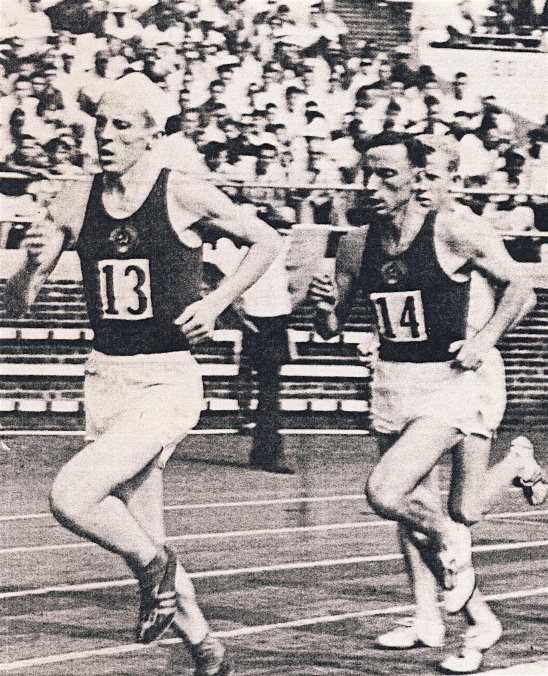 |
| Bob Soth (right) follows Parnakivi andDesyatchikov in the 1959 10,000. |
10,000 This was a race full of drama. Three of the four runners collapsed from the 85’ heat. As well, the laps were not counted correctly. The USSR fielded two runners from the previous year: Parnakivi, who won the 5,000, and Desyatchikov, who was 2nd in the 10,000. Max Truex, who was 3rd in the 5,000 in 1958, and Bob Soth ran for the USA.
After the Russians led for the first eight laps, Soth took over. Truex, surprisingly, had already been dropped. Soth led for four laps, and then Desyatchikov took over. At the halfway point Truex was almost half a minute behind. Controversy arose later because the Russians claimed that Parnakivi, who was second, lapped Truex at this point. (Was there no film of the event?)
Desyatchikov continued to lead up to five miles, with Parnakivi 8 seconds back and Soth 10. Soth then moved into second, after Parnakivi slowed to 80-second laps. Both Desyatchikov and Soth lapped Truex. Then Soth began to run “with the weird and shocking high-stepping backward lean of a runner who is in serious trouble.” (George Grenier, Track & Field News, August, 1959). “This went on for way too long,” Don Truex recalls. “They wanted the points.”
On lap 22 Desyatchikov lapped Parnakivi, and Truex passed the faltering Soth, who collapsed into unconsciousness soon after. As if this wasn’t enough, the gun for the last lap was fired too late and Desyatchikov had to run an extra lap. Truex, who had slowed to a 90-second lap, suddenly realized that Parnakivi could be caught. He put in an amazing sprint to pass the Russian and then ran the extra lap as Desyatchikov had done. Truex collapsed after this. And Parnakivi just made it to the finish before collapsing himself. He had run the last 376 yards in 1:54.8.
More controversy followed: poor Truex was not given second place, the Russians claiming that Parnakivi had lapped him near the halfway mark—at which point Truex trailed the Russians by only 24 seconds. There was no American protest over this. This may have been the most chaotic international distance race of the century.
1. Desyatchikov 31:40.6; 2. Parnaviki 32:49; 3. Truex 33:13. Actual (according to T&FN): 1. Desyatchikov 30:29.9; 2. Truex 32:49.6; 3. Parnaviki 33:13.4.
Running Result: USA 22, USSR 23. Overall Result: USA won 127-108.
ROUND 3
Moscow, July 15-16,1961
Some of the bonhomie of the first Moscow meet had gone. The Russians fouled up the American flight plans, delaying them by a day at the last minute with the flimsy excuse that there was an air show at Moscow Airport. As well, the efforts at hospitality that had impressed on the previous visit were noticeably absent this time. Clearly the Russians were taking the series more seriously, the Soviet press calling it the Match of Giants. But the Americans were also taking things more seriously. Accordingly three world records were broken in the High Jump, Long Jump and 4x100 relay. As well this meet attracted much better crowds: 60,000 for Day 1 and 70,000 for Day 2. Sports Illustrated called the meet “a splendid success.”
For the first time in the series, American runners outscored the Russians.
800 Bulishev took the field through a fast 51.8 first lap, enabling three PBs in this one race. However, this tactic did not work for the Russians as Jerry Siebert, tying his PB at just the right time, took the race with a clear margin. Running in third along the back straight, he followed James Dupree past Bulishev on the last curve and then powered past his teammate to the tape. Dupree just held off Savinkov for second. Both Dupree and Savinkov also recorded PBs.
1. Siebert 1:46.8; 2. Dupree 1:47.3; 3. Savinkov 1:47.4; 4. Bulishev 1:48.2.
1,500 Despite the absence of Burleson through food poisoning, American stars Beatty and Grelle looked like certain winners, although the last-minute appearance of 800-specialist Savinkov made the race look more interesting. Beatty was in complete control throughout and delivered a withering final sprint that took him1.5 seconds ahead of Grelle at the tape. Beatty’s time was a meet record. Grelle again scored valuable points in this his third appearance in this series. Savinkov was never really in the race.
1. Beatty 3:43.8; Grelle 3:45.3; 3. Byelitsky 3:46.2; 4. Savinkov 3:48.8.
5,000 Olympic 10,000 champion Pyotr Bolotnikov needed to be in good form to take this race. American Max Truex, who had finished sixth in the Rome Olympic 10,000, was now a bona-fide world-class distance runner. And Truex rose to the occasion. He hung on to the Russian in the early stages and even took the lead for four laps in the second half of the race. But at the bell, Bolotnikov took charge and built up a 7-second lead by the tape. Despite his defeat, Truex did well to defeat Samoilov. He was the only American distance runner able to compete properly with the Russians.
1. Bolotnikov 13:58.4; 2. Truex 14:05.4; 3. Samoilov 14:14.8; 4. Clark 14:45.4.
10,000 The inexperienced American pair, Gutknecht and Kitt, were no match for the Russians. Zakharov and Virkus took turns in the lead, although Gutknecht hung on to them tenaciously. “That was some pace,” he said afterwards. “I broke my three-mile record of 14:01 by several seconds, and we were running more than six miles.” (Sports Illustrated, 24 July 1961) By 7K the Russians were well clear. In a private Soviet battle, Zakharov took charge, his winning margin stretching to 8.6 seconds.
1. Zakharov 29:34.4; 2. Virkus 29:43.0; 3. Gutknecht 30:13.8; 4. Kitt 32:47.8.
Running Result: USA 23, USSR 21. Overall Result: USA won 124-111
ROUND 4
Stanford, California, July 21-22, 1962
Stanford made huge efforts to host this fourth meet of the series, even agreeing to pay off the $53,000 AAU debt from the 1961 Moscow trip. The Cold War was hotting up after Gary Powers’ spy plane was shot down over the Soviet Union and while the Soviets were preparing to seal off Berlin. And just before the meet was held, Soviet scientists were sent to Cuba to start installing missiles.
Nevertheless the USSR tem was accorded the traditional American hospitality. They were accompanied by four KGB agents but were given a lot of freedom to sightsee. They did not encounter any demonstrations.
The meet attracted crowds of 72,500 and 81,000. And the closing ceremony saw an amazing display of goodwill: “Soviet and Americans waved their flags, blew kisses to the crowd and walked arm-in-arm in a spontaneous, unrehearsed celebration. The crowd stood and cheered the athletes all the way round the track. In the stands and on the field, people wept unabashedly. Nobody wanted to leave.” A veteran reported from the San Francisco Examiner told meet organizer Jordan, “This is the first time I’ve cried at an athletic event.” (See Gary Cavilli, Cold War, Warm Welcome, Stanford University website)
This time there were records in the High Jump and Hammer. Pyotr Bolotnikov scored an impressive double in the distance races.
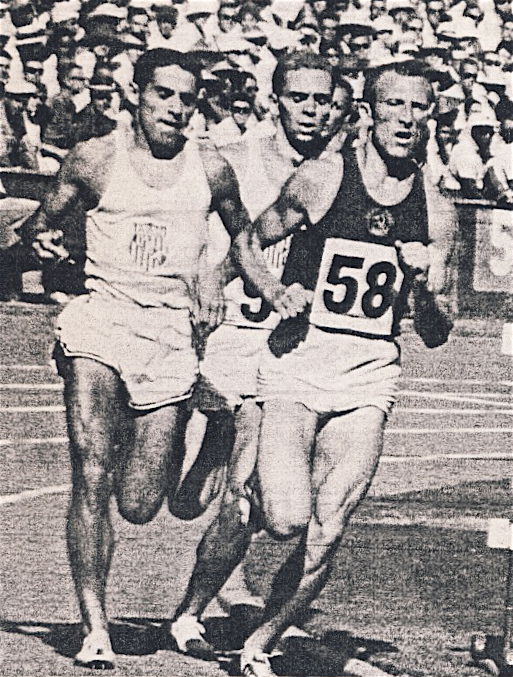 |
| 1962: Jim Beatty stays close to Byelitsky (58), while Forman keeps to the inside. |
800 Jerry Siebert and Jim Dupree continued to shine as last year, again placing first and second, though in faster times. The combative Bulishev again had a impact on the race. After the second-string Russian Krivosheyev had taken the field through the bell in 52.5, Dupree and Bulishev shared the lead into the last bend after holding off Siebert. But in the last 100 Siebert was not to be denied and proved the strongest, although Dupree was close at the tape. Siebert had been hoping for an American record in this his last race; his winning time was only 0.8 slower than Tom Courtney’s record. Both Russians were well beaten.
1. Siebert 1:46.4; 2. Dupree 1:46.8; 3. Bulishev 1:48.0; 4. Krivosheyev 1:49.6.
1,500 This was a great race that produced both USSR and USA records. The fast pace was all the work of Russian Byelitsky, who led through 57.8, 1:57.8 and 2:57.7. Clearly his tactic was to use a fast pace to take the sting out of Beatty’s famed kick. Americans Jim Beatty and Keith Forman went along for the ride, while the second Russian, 800 specialist Savinkov, was never in contention. Beatty took charge on the back straight of the last lap to emerge as a convincing winner. The real excitement was over the race for second. Keith Forman, who had entered as a replacement for an injured Jim Grelle, ran the race of his life, passing Byelitsky to lead him into the straight. But the Russian fought back and regained second place just 40m from the tape. The first two ran national records. Beatty’s time was just inside his 3:40.2 PB from 1961.
1. Beatty 3:39.9; 2. Byelitsky 3:41.0; 3. Forman 3:41.2; 4. Savinkov 3;48.8.
5,000 Bolotnikov had no trouble here. In the first part of the race, he played around a little with American Charlie Clark. He ran the first four laps in 4:23.5 and the next four in 4:35.5, before letting Clark take the lead for a while. The Russian then put in two 66 laps, which put him clear for good. He was well supported by his team-mate Artinyuk, who easily beat Clark for second.
1. Bolotnikov 13:55.6; 2. Artinyuk 14:05.4. 3. Clark 14:09.8; 4. Gutknecht 14:31.5.
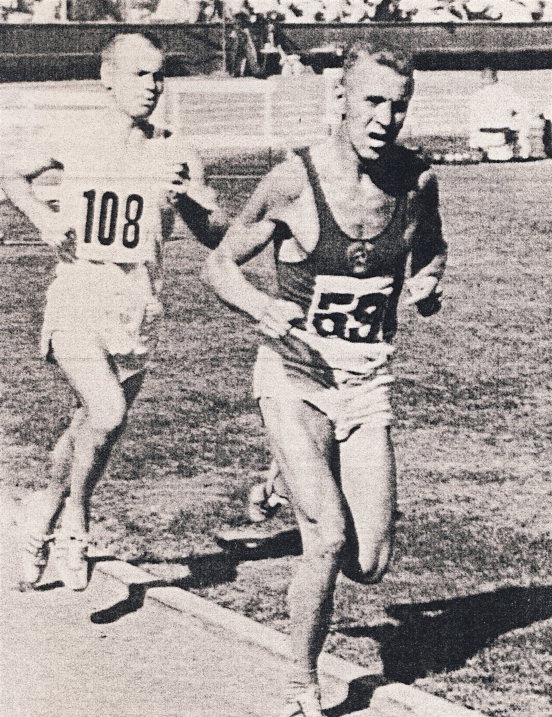 |
| Max Truex (108) was able to stay with Bolotnikov for 21 laps. |
10,000 Bolotnikov was brought into this race as well as the 5,000 because the US switched their best distance runner to this event—Max Truex. Bolotnikov led from the start, with Truex close behind. The Russian tried to escape early, on the third lap, but Truex stayed with him. With laps ranging from 65.5 to 74.9, Bolotnikov led at 5,000 with 14:27. Then he settled down within the range of 72-74 laps. Truex, suffering from blisters on both heels, cracked with four laps to go. The plucky American in fact beat American all-comers records for 4,5,and 6 Miles (18:52.4, 23:43.5, 28:38.2). As well, Bolotnikov was on his way to the fastest 10,000 ever run on US soil. Leonid Ivanov was able to pass the broken Truex to make this race a clean sweep for the USSR. Because of a huge blood blister on the ball of his foot, Truex could only run 73.4 for his final 400.
1. Bolotnikov 29:17.7; 2. Ivanov 29:30.3; 3. Truex 29:36.1; 4. McArdle 30:57.3.
Running Result: USA 21, USSR 23. Overall Result: USA won 128-107
ROUND 5
Moscow July 20-21,1963
The 1963 Russian team under Coach Korobkov was probably the strongest yet. But they performed in front of very small crowds—only 30,000 on Day 1. The US weakness in the distance events was painfully apparent, especially with the absence through injury of Jim Beatty.
800 American first-stringer Jerry Siebert had now retired, so Dupree, who had run second in the two previous meets, was now joined by Morgan Groth. Both Bulishev and Krivosheyev were back for the USSR. As last year, Krivosheyev led at the bell (51.7). The four were still closely bunched at 600 with Dupree on Bulishev’s shoulder and Groth on Krivosheyev’s. Dupree led into the last 80, but Bulishev managed to pass him with 30m to go. Dupree, however, dug down and managed to respond and hit the tape just in front. Groth ran well for a comfortable third.
1. Dupree 1:47.8; 2. Bulishev 1:48.0; 3. Groth 1:48.6; 4. Krivosheyev 1:50.8.
1,500 The two Russian veterans, Savinkov and Byelitsky, were no match for the younger Americans. The Russians led for almost three laps before O’Hara jumped the field. He was well away before Burleson reacted. With the Russians falling behind, Burleson gradually pulled back his team-mate and passed him only 20m from the tape.
1. Burleson 3:41.0; 2. O’Hara 3:41.3; 3. Savinkov 3:44.8; 4. Byelitsky 3:45.6.
5,000 Total Russian domination. Yuri Tyurin and Leonid Ivanov not only ran fast times but also left the two Americans, Keefe and Fishback 40 and 61 seconds in arrears.
1. Tyurin 13:50.0; 2. Ivanov 13:50.4; 3. Keefe 14:30.0; 4. Fishback 14:51.4.
10,000 More Russian domination. Ivanov was again earning points for his country, with team-mate Yefimov not far behind. McArdle ran well but was clearly outclassed.
1. Ivanov 29:10.2; 2. Yefimov 29:25.0; 3. McArdle 29:46.0; 4. Edelen 30:04.0.
Running Result: USA 21, USSR 23. Overall Result: USA won 119-114.
ROUND 6
Los Angeles, July 25-16, 1964
There were still good crowds for this Los Angeles meet (106,400), but they were below the 153,500 total at Stanford two years earlier.
For the first time, the US won all four races. Finally American runners were becoming a factor on the international scene. Bob Schul and Gerry Lindgren appeared in this series for the first time.
800 Jerry Siebert came out of retirement to win for the third time in this series. He and Darnell Mitchell of Ohio University easily took maximum points.
1. Siebert 1:47.6; 2. Mitchell 1:48.9; 3. Telp 1:49.9; 4. Krivosheyev 1:52.4.
1500 Jim Grelle was pushed by Russian Byelitsky, but he had a comfortable one-second margin at the end. Morgan Groth looked good for second until the final straight.
1. Grelle 3:41.3; 2. Byelitsky 3:42.3; 3. Groth 3:45.7; 4. Aleksiejunas 3:52.0.
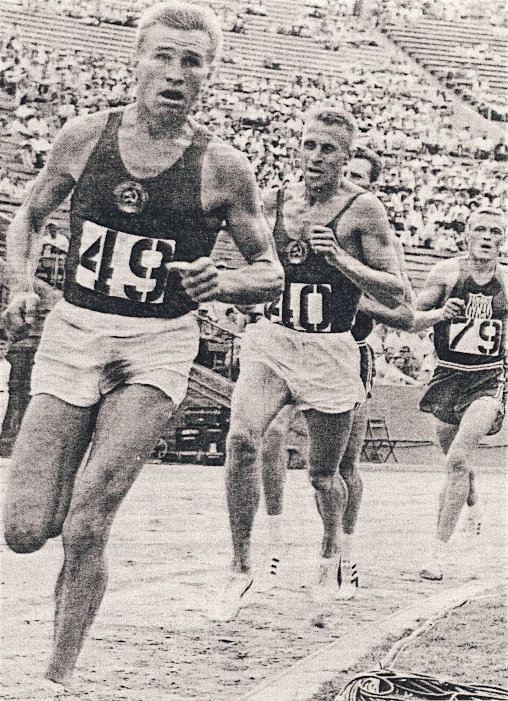 |
| Orentas and Bolotnikov push the pace ahead of Schul and Dellinger. |
5,000 The Russians were perhaps unaware of the finishing speed of Bob Schul and Bill Dellinger, both of whom were to run brilliantly later in the season in Tokyo. Bolotnikov was not in good shape anyway, and Orentas was inexperienced internationally. The pace was barely faster than this meet’s 10,000, so the four competitors were still together at the bell. As the Americans had planned, they went for it with 320m to go. Dellinger was the first to make his move. But Schul was quickly ahead as both of them left the Russians standing. Schul was almost two seconds ahead of Dellinger at the tape, covering the last lap in 54.4. Meanwhile, the two Russians could only coast in for the minimum points.
1. Schul 14:12:4; 2. Dellinger 14:14.2; 3. Orentas 14:18.0; 4. Bolotnikov 14:20.0.
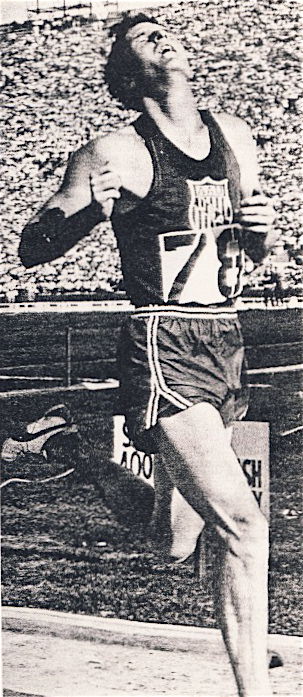 |
| Lindgren wins the 10,00 by 22 seconds. |
10,000 This race captured everyone’s interest as a diminutive 18-year-old American kid tackled two experienced sub-29:00 Russians. Gerry Lindgren, whose PB was 50 seconds slower than the Russians’, didn’t give an inch. He stayed with the two Russians for the first 15 laps, but hesitated when Ivanov broke away from his colleague and established a 20m lead. It only took a word from his coach to go after the leader if he felt good. Lindgren sprinted, quickly caught the Russian, and then opened up his own lead. He then continued to move away from Ivanov and with a 63.6 last lap had well over 100m lead at the tape. So despite the heroics of Truex in previous races in this series, this was the first time an American had won the 10,000. Dutov, who was third, was commendably stoic as he was hit on the thigh by a women’s discus (thrown by a Russian woman) in the second lap. The next day the Russian coach blamed the LA smog for his runners’ poor performance. He might also have mentioned the 90-degree heat these distance runners had to endure. Ivanov’s reckless first 5,000 in 14:07 in such heat was unworthy of an experienced distance runner.
1. Lindgren 29:17.6; 2. Ivanov 29:39.8; 3. Dutov 30:51.8; 4. Gutknecht 31:22.2.
Running Result: USA 29 USSR 15. Overall Result: USA won 139-97.
ROUND 7
Kiev, July 31-August 1, 1965
This was the very first time that the USSR won this meet. Interestingly, Sports Illustrated, which had always covered the series in detail, had no feature article this time, just a brief entry under “Sports Information of the Week.” The defeated US team was described as “weakened by assorted ailments and injuries and—perhaps—overconfidence.” (SI, August 9, 1965)
800 George Germann needed a PB to win this race. Estonian runner Tolp led at the bell in 51.6. Germann stayed with Tolp until the last bend, when he moved past for an easy victory. Bulishev passed Tolp for second, while the other American, Morgan Groth, limped home injured to get his one point.
1. Germann 1:46.8; 2. Bulishev 1:47.6; 3. Tolp 1:48.0; 4. Groth 2:17.0.
1,500 This race saw the first appearance of Jim Ryun, who was apparently unwell. He and Grelle controlled the race after a fast early ace by Raiko. Grelle coasted in the winner in what was the easiest but still fastest of his three wins in this series. Ryun seemed content to finish in second as the Americans enjoyed an easy victory and full points.
1. Grelle 3:39.2; 2. Ryun 3:40.4; 3. Byelitsky 3:42.0; 4. Raiko 3:44.4.
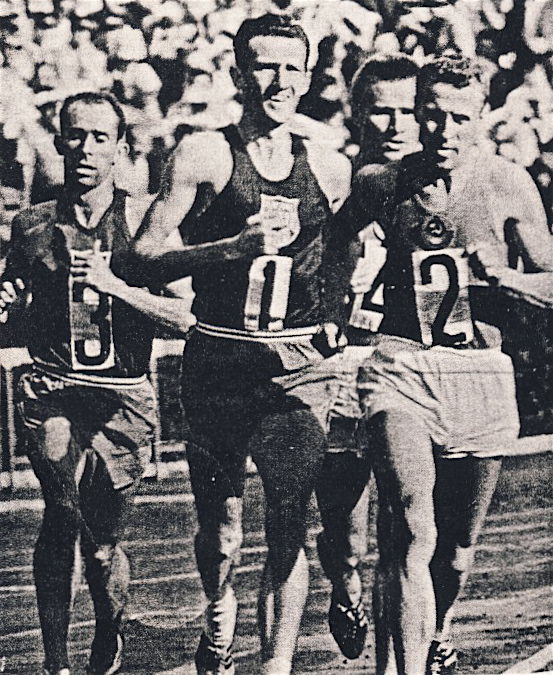 |
| Bob Schul (1) and Ron Larrieu follow Bolotnikov (2). Only 0.6 of a secondwill separate these three at the tape. |
5,000 Olympic champ Bob Schul was up against another Olympic champ—Pyotr Bolotnikov, who had won the 10,000 in 1960. Neither runner was in top form as both were dealing with injuries. But there was an exciting race, at least in the last lap. The runners were together at the bell, when Bolotnikov made his effort. He had 3-meter lead on the back straight, but then Schul and Ron Larrieu went after him. Schul took the lead with 200 to go, but when he slowed after feeling a tear in his calf on entering the straight, Bolotnikov was able to regain the lead. Schul, however, did not give up. He slowly pulled back the Russian and made a desperate dive for the tape. Despite this, the tough Bolotnikov was able to hold on for a narrow victory. Larrieu got very close to his team-mate on the exciting run-in.
1. Bolotnikov 13:54.2; 2. Schul 13:54.4; 3. Larrieu 13:54.8; 4. Orentas 14:00.8
10,000 Gerry Lindgren, last year’s dramatic winner in this event, again faced Dutov and Ivanov. This time he had a cold and although he ran a PB, he was no match for the veteran Russian runners, who were encouraged by the huge home crowd. Lindgren held on to the Russians for over half the race before losing contact. The Russians ran equal splits, with Dutov much the fastest over the last lap. His time of 28:22.0 was the third fastest time in history. Behind the Russians both Lindgren and Bill Morgan ran PBs. The American team missed Olympic champ Billy Mills for this event. Still, even a top-form Mills would have found it hard to match the fine runs of Dutov and Ivanov.
1. Dutov 28:22.0; 2. Ivanov 28:29.8; 3. Lindgren 29:00.8; 4. Morgan 29:32.0.
Running Result: USA 24, USSR 20. Overall Result: USSR won 118-112.
Individual Point Totals
(5,3,2,1 scoring)
USSR: Bolotnikov 25
Ivanov 17
Byelitsky 11
Savinkov 9
Bullishev 8
Parnakivi 8
Desyatchikov 8
USA: Grelle 21
Siebert 15
Dupree 14
Beatty 10
Burleson 10
Truex 9
Dellinger 8
Schul 8
4 Comments